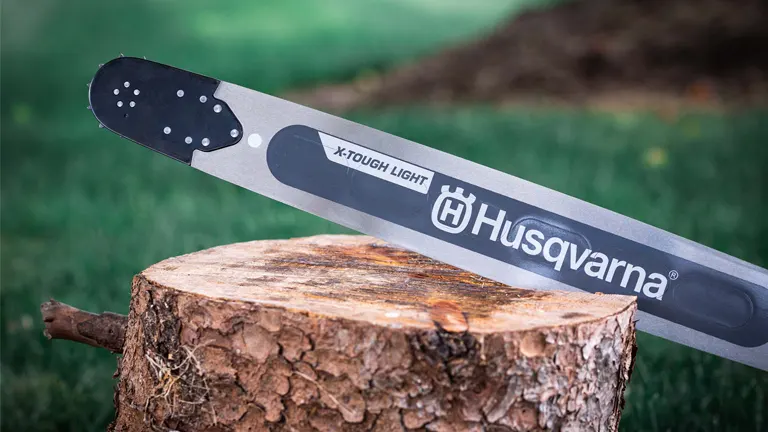Best Bar and Chain for Cutting Notches?
- February 12, 2024
- 0 comment
When it comes to cutting notches, whether for timber framing, creating joints in woodworking, or preparing trees for felling, the right tools can make all the difference. The bar and chain of your chainsaw are pivotal in ensuring clean, precise, and efficient cuts. This article will guide you through choosing the best bar and chain combination for cutting notches, focusing on key features such as bar length, chain type, and other considerations that affect performance and outcome.
Understanding Notching
Notching requires precision and control, as it often involves removing small sections of wood to fit together with another piece or to create a guided direction for a tree to fall. The accuracy of the notch can significantly influence the structural integrity of a joint or the safety of a tree felling operation.
Choosing the Right Bar

Length Matters
- Short Bars (10″-14″): These bars excel in precision work, offering unmatched control for intricate notching in woodworking projects. Ideal for crafting detailed joints or artistic cuts, short bars allow for tight maneuverability and are perfect for tasks requiring fine detail. They are particularly suited for hobbyists and professionals working on complex designs or in confined spaces where accuracy is paramount.
- Medium Bars (16″-20″): Striking a perfect balance between control and cutting capability, medium bars are the versatile choice for a broad spectrum of notching tasks. Whether you’re felling small trees, creating notches for timber framing, or working on moderate construction projects, these bars provide the flexibility needed to switch between tasks with ease. Their adaptability makes them a favorite among general contractors and those who need a one-size-fits-most solution for both precision work and moderate felling.
- Long Bars (Over 20″): Designed for the most demanding tasks, long bars are the go-to for notching and cutting large trees. Their extended length enables users to tackle big diameters and dense materials without compromising on efficiency. However, it’s important to note that while they offer the power needed for large-scale operations, their size can make precision work more challenging. Ideal for forestry professionals and those involved in major construction projects, long bars should be handled with experience due to their increased weight and the leverage they provide.
Bar Profile and Material
- Narrow Kerf Bars: Are engineered to make finer cuts with less material removal. This not only increases cutting efficiency but also reduces the power needed from your chainsaw, making your tool more efficient and easier to handle during detailed notching tasks. Ideal for users who prioritize accuracy and efficiency, narrow kerf bars are perfect for detailed architectural elements, fine woodworking, and any project where every millimeter counts.
- Durable Materials: The longevity and reliability of your chainsaw bar are non-negotiable. Opt for bars crafted from high-quality, heat-treated steel that resists bending and wear. A durable bar ensures consistent performance over time, reducing the need for frequent replacements and maintaining precision in your notching work. Look for bars that feature reinforced tips and are designed to withstand the rigors of heavy use, ensuring your investment stands the test of time.
Selecting the Right Chain

Chain Type
- Chisel Chains: These chains feature sharp, square-cornered cutters, making them the top choice for producing clean, precise notches quickly and efficiently. Best suited for projects where clean cuts are crucial and the wood is free from dirt and debris.
- Semi-Chisel Chains: Equipped with rounded cutters, semi-chisel chains are more forgiving in environments where dirt and debris are present. Their resilience makes them ideal for notching under various conditions, ensuring consistent performance even when precision is challenged by external factors.
Pitch and Gauge
- Pitch: This measures the distance between the chain’s drive links. Opting for a lower pitch, such as 1/4″, enhances control and precision, making it an excellent choice for detailed notching work where every millimeter matters.
- Gauge: Refers to the drive link’s thickness. A chain with a thinner gauge delivers finer, more precise cuts, aligning perfectly with the needs of intricate notching tasks. It’s crucial for achieving the level of detail demanded in high-quality craftsmanship.
Top Recommendations
For Woodworking

When it comes to woodworking, precision is key, which is why a 14″-16″ narrow kerf bar is highly recommended. For instance, the Oregon Micro-Lite Bar is designed to provide exceptional precision, allowing for meticulous detail in your work. Its narrow kerf design ensures that less material is removed with each cut, which not only improves the chainsaw’s efficiency but also enhances control, making it perfect for detailed notching and intricate designs. Paired with this bar, a low-profile chisel chain, such as the STIHL Picco Micro Chain, is ideal. Its design is optimized for achieving clean, precise cuts, making it the perfect companion for woodworking projects where detail and finish are paramount. This combination ensures that craftsmen can achieve the exacting standards required for fine woodworking with ease.
For Tree Felling

For the demanding task of tree felling, selecting a bar and chain that can handle the rigors of cutting through thick bark and dense wood is essential. An 18″-20″ durable bar, like the Husqvarna X-Tough Bar, offers the necessary stability and control required for handling large trees. Its robust construction is specifically designed to withstand the tough conditions of tree felling, ensuring that the bar remains reliable over time. Complementing this bar, the Oregon PowerCut Full Chisel Chain is an excellent choice for those seeking efficient cutting performance. Known for its fast, efficient cutting capabilities through thick bark and wood, this chain’s aggressive cutting style is ideally suited for tree felling operations. It offers the power and reliability needed to make quick work of large notches and complete felling tasks more effectively. Together, this bar and chain combination provides a powerful toolset for professionals and serious enthusiasts who demand high performance and durability in their tree felling equipment.
Maintenance and Safety
Proper maintenance of your bar and chain is crucial for ensuring the longevity of your equipment and safety during notching tasks. Regularly clean and sharpen your chain, ensure your bar is straight and free of nicks, and always wear appropriate safety gear.
Conclusion
The best bar and chain for cutting notches depend largely on the specific task at hand. For woodworking and detailed notching, a shorter bar with a narrow kerf and a low-profile chisel chain is ideal. For larger tasks like tree felling, a longer bar paired with a full chisel chain offers the necessary power and efficiency. Regardless of the job, proper maintenance and safety practices are paramount. With the right equipment and care, you can achieve precise and clean notches for any project.
FAQs
- How do I choose the right bar length for specific trees?
The right bar length depends on the diameter of the tree you intend to notch. As a general rule, the bar length should be at least 2 inches longer than the diameter of the tree. For trees up to 12 inches in diameter, a bar length of 14-16 inches is usually sufficient. For larger trees, consider a bar length of 18-20 inches or more. Remember, longer bars can handle larger trees but may be more challenging to control, so balance size with manageability. - What’s the best chain for cutting hardwood versus softwood?
For hardwoods, a full chisel chain is often preferred due to its square-cornered teeth, which cut more efficiently through dense wood. However, they can be more prone to kickback and require more precise handling. For softwoods, a semi-chisel chain might be better as it’s more tolerant of dirt and debris, which can be common in softer woods, and its rounded corners make it safer and easier to use. Always consider the specific conditions and your experience level when choosing. - Can the same bar and chain be used for both notching and general cutting?
Yes, the same bar and chain can be used for both notching and general cutting tasks. However, the effectiveness will depend on the specifics of the job. A setup optimized for notching might not be the best for long, straight cuts through thick logs and vice versa. If you frequently alternate between tasks, consider a versatile medium-length bar and a semi-chisel chain as a good compromise. - How can I extend the life of my chainsaw bar and chain?
Regular maintenance is key to extending the life of your chainsaw bar and chain. Keep the chain sharp, as a dull chain increases wear on both the chain and the bar. Clean the bar and chain after each use to prevent buildup of sap and debris. Lubricate the chain regularly to reduce friction and wear. Also, periodically check the bar for wear and flip it to ensure even use. Avoiding cutting with the tip of the bar can also prevent unnecessary stress and minimize the risk of kickback. - What is the significance of chain pitch and gauge, and how do they affect notching performance?
Chain pitch refers to the distance between the drive links on the chain and affects the size of the cut and the smoothness of operation. A lower pitch means smaller teeth and closer spacing, which can be good for detailed work but might cut slower. Gauge refers to the thickness of the drive links and determines how well the chain fits in the bar groove. A correct match between bar groove and chain gauge is crucial for safe and effective cutting. A mismatch can lead to poor performance or even accidents. - Is it worth investing in a professional-grade bar and chain for occasional notching work?
For occasional use, a consumer-grade bar and chain might be sufficient and more cost-effective. However, if you demand precision, or if your notching work involves hard materials or complex projects, investing in professional-grade equipment can be worthwhile. Professional-grade tools typically offer better durability, precision, and ease of use, which can make the task quicker, safer, and more enjoyable. - How often should I sharpen my chain, and does it affect notching accuracy?
The frequency of sharpening depends on use, but it’s generally recommended to sharpen the chain after every few hours of operation, or whenever you notice a decrease in cutting performance. A sharp chain is crucial for notching accuracy, as a dull chain can wander or produce rough, uneven cuts. Keeping the chain sharp ensures clean, precise notches and reduces the physical effort required to make cuts.
We’ve reached the end of our guide on selecting the best bar and chain for cutting notches, but the conversation doesn’t have to stop here. We’re eager to hear about your experiences and any tips or recommendations you might have. Please feel free to share your thoughts in the comments below. Your input can help enrich our community’s knowledge and assist others in making informed decisions for their notching tasks. Let’s keep the dialogue going and continue to support each other in mastering the art of precise cutting!

David Murray
Forestry AuthorI'm David Murry, a forestry equipment specialist with a focus on chainsaw operation. With over 13 years of experience, I've honed my skills in operating and maintaining a wide range of machinery, from chainsaws to log splitters. My passion for the outdoors and commitment to sustainable forestry drive my work, which emphasizes safety, efficiency, and staying updated with industry advancements. Additionally, I'm dedicated to sharing my expertise and promoting environmental awareness within the forestry community.












Leave your comment